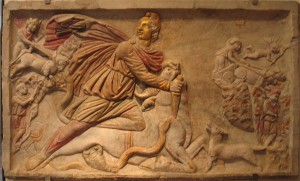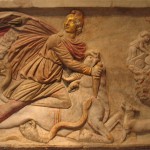 On Easter I wrote a post called Happy Sex Goddess Day. The post showed that the name “Easter” really came from Ishtar, the sex goddess, but through the process of cultural redemption, nobody thinks of Ishtar on this day anymore, but of the resurrection of Jesus Christ. The post was somewhat controversial on my Facebook page, and even had a professor from my former seminary weigh in.
On Easter I wrote a post called Happy Sex Goddess Day. The post showed that the name “Easter” really came from Ishtar, the sex goddess, but through the process of cultural redemption, nobody thinks of Ishtar on this day anymore, but of the resurrection of Jesus Christ. The post was somewhat controversial on my Facebook page, and even had a professor from my former seminary weigh in.
Pagan Roots of Christmas
So this Christmas season, I’m wishing all of you “Merry Mithras!” Whether you realize it or not, Jesus was probably not actually born on December 25. Historically, December 25 was a day to celebrate the god Mithras and his connection with winter solstice. But again, through the process of cultural redemption, few people think of Mithras on December 25. Instead, it is a day to celebrate the birth of Jesus Christ.
But here is an additional point I want to make. One of the guys I meet with in my church planting Bible study, the one who is agnostic, reminded us all on Thursday as we were reading Matthew 2, that all of this was just plagiarized from pagan myths of Osiris and Mithras. None of it really happened. It wasn’t the time or place for me to attempt to “correct” him, because after all, we agreed to not argue and debate with each other.
But I can post my thoughts on this blog as I made no such agreement with you.
Pagan Roots of Christianity
 Several years ago, I wrote a post about an online movie called Zeitgeist: The Movie. A pantheistic friend of mine asked me to watch it.
Several years ago, I wrote a post about an online movie called Zeitgeist: The Movie. A pantheistic friend of mine asked me to watch it.
The basic premise of the movie (the first half anyway), is that the biblical accounts of the birth, life, death, and resurrection of Jesus were all plagiarized from ancient myths about Osiris, Dionysus, Adonis, and Attis. The movie claims, among other things, that some of these myths are about people who were born of a virgin on December 25, had twelve followers, performed miracles, died, and rose again. As a result, it is argued, the story of Jesus is just a myth also.
I’ve done a lot of thinking about this since I first made that post, and have come to this conclusion:
Defending Christianity
First, I have done some reading into the myths of Osiris, Dionysus, and some of the other mythical parallels, and to be honest, I can’t find many of the matching details that supposedly exist. It is claimed, for example, that Mithras was born of a virgin on December 25. Well, he was born on December 25, but he came out of rock, not a woman. Coming from a rock is quite different than being born of a virgin.
 Furthermore, though we celebrate the birth of Jesus on December 25, few people believe he was actually born this day, nor does the Bible ever say that this is the day of His birth. The parallel is contrived.
Furthermore, though we celebrate the birth of Jesus on December 25, few people believe he was actually born this day, nor does the Bible ever say that this is the day of His birth. The parallel is contrived.
So before someone begins doubting the accuracy of the Gospel accounts of Jesus based on some supposed parallels to ancient Persian, Greek, and Egyptian mythology, it would probably be wise to check the facts on the ancient mythology.
Second, it might also be wise to check the historical chronology of some of these myths. Take Mithras as an example. Sure, there are some striking similarities between Mithras worship and early Christian worship. See this site for some of these. But by digging a little deeper, you discover that the Roman cult of Mithras probably didn’t develop until the late First Century A.D.
Yes, that’s right, the events of the Gospels happened first. The early Christian apologist, Justin Martyr accused members of the Mithras cult of stealing the beliefs and practices of Christianity for their own religion! So who plagiarized whom?
But let’s give these myths the benefit of the doubt. Let’s say the parallels really do exist, and let’s say that they really do predate the Gospel accounts. Does this mean that the accounts of Jesus should now be considered myth?
The Myth of You
You can answer this question by googling your name. Go ahead. When I googled “Jeremy Myers” I found that there are several other people alive today with the name “Jeremy Myers.” A few of them even have some similarities to me… similar age, similar interests, etc. I didn’t research any of them in depth, but if I could sit down with some of them, I’m sure we would discover some striking similarities. Does this mean that some or all of us are myths? All of us (if Google can be trusted) are real, living, breathing, human beings. Imagine trying to argue that because there is more than one “Jeremy Myers,” and we share some striking similarities, we are all mythical.
The Titanic Myth
 Or let me approach this another way. Did you ever hear the story of a fancy ship that ran into an iceberg on its maiden voyage and sank as a result, killing more than half of the people on board because there were not enough lifeboats? No, I’m not talking about the Titanic. The name of the ship was the Titan, and this was the plot of a fictional novel called Futility: the Wreck of the Titan, which was written by Morgan Robinson in 1898, fourteen years before the historical events of the Titanic. Can we say that since Morgan Robinson’s fictional story has so many striking parallels to the events of the Titanic, that the sinking of the Titanic must also be fiction?
Or let me approach this another way. Did you ever hear the story of a fancy ship that ran into an iceberg on its maiden voyage and sank as a result, killing more than half of the people on board because there were not enough lifeboats? No, I’m not talking about the Titanic. The name of the ship was the Titan, and this was the plot of a fictional novel called Futility: the Wreck of the Titan, which was written by Morgan Robinson in 1898, fourteen years before the historical events of the Titanic. Can we say that since Morgan Robinson’s fictional story has so many striking parallels to the events of the Titanic, that the sinking of the Titanic must also be fiction?
Of course not. But this is the argument used to discredit the historical account of Jesus.
If you don’t believe the events in the Gospels really happened, you should have better reasons than the (questionable) idea that since the Gospels contain parallels to ancient myths, the Gospels must also be myths. To believe or disbelieve the historical accuracy of the Gospels, you must study them on the strength of their own historical evidence, not because of their real (or supposed) parallels to pagan myths. I, for one, believe that the Gospels contain some of the most accurate and reliable history ever written.
I believe that Jesus truly was born (maybe not on December 25, but does it really matter?), lived, taught, died on the cross, and rose again, just as the Gospel accounts say.
And that’s part of the reason I can wish you, and everybody I meet, “Merry Christmas!”
P.S. I wrote more about this topic in my short eBook, Christmas Redemption. You can get it on Amazon for only $0.99.




Hey buddy!
Anyone who seriously tries to discredit the whole of Jesus’ story as parallel to ancient myths is engaged in very short-sighted debate. There are so many more concrete points to argue without resorting to who stole what from whom. I think it’s fairly clear, though, that the nativities, themselves, are probably stories without much real basis in fact. The fact that there are two different stories would suggest that at least one was made up. I was actually taught in Catholic school that they were both just stories and that Luke’s was cribbed from various myths because he was a pagan and pagan gods came into the world with sensational events and circumstances.
That’s more likely what your agnostic friend was trying to convey. Again, though, to try and extrapolate that into a complete denial is overreaching. What I took from Luke’s nativity was something a little simpler: If that story isn’t “true”, what else isn’t? Growing up Catholic, however, it simply didn’t matter. 🙂
Happy New Year, my friend.
I owe you an email – lots going on with me.
Bullet,
Good to hear from you. Is your acting career going well? I hope so. I check your blog every now and then, but haven’t seen much action there in quite a while.
Hope you have a GREAT 2011.
Jeremy
Did Simaramus marry Cush and bore Nimrod than married Nimrod and bore Tammus than married Tammus and bore Mithras?
adoniaiah,
Eh…what?
Sir,
While surfing website to in search of Isthar/ Eshar, I landed on your blog.
Thanks as you gave me some new thoughts.
You might have heard of an Indian Goddess, Called Durga. She is described as a 10-handed Goddess who killed Mahisasura, the Buffello demon, riding on a Lion.
But, to me, she is a tribal lady of matriarchial period who had to fight with several odds, even from the then tribal war groups, sometimes led by war lords. (Shur in sanskrit means King. Asura – the evil those who were dscendents of Asirian King Asurbanipal.
Ezthar and Mitrahs five me clear indication that I am right. The Concept of Durga is from Asirian culture.
I’ve always heard, it was never stolen, but actually slipped in, and a lot of that was done, since pretty much every Christian religion is the overtone of a Pagan Holiday, I believe it could have been done with the intent of two things, make Christianity look like a joke by obscuring the fundamentals of the belief, or get people to make sociable acceptable pagan practices, in modern culture (for what ever reasons) by using christian make-up to change the picture.
And it is quite clear people drew the connection and made the Holiday’s happen, not the other way around
I am not sure exactly how the transition occurred. I have even heard some say that the pagan writings and traditions were changed to match the Christian beliefs and practices, and that is why there are similarities.
I don’t either, but I did a little research on it, probably not enough to be credible, but I noticed something interesting, which seems to make a bit of sense.
Rome had their post-Greek pagan religion for about 3-4 centuries after Jesus death, them and the Jews also supposedly had persecuted Christians until Constantine came around and established Christianity as the main religion of Rome.. of course, it was actually Catholicism but it’s heavily referred to as Christianity because they’re similar branches, and was later named Roman Catholicism even in the 17th century.
The bible would have taken roughly a century to get into proper circulation, and only two and a bit centuries later, it’s quite possible that maybe it grew on some of the Romans and out of remorse, re-considered that they actually were responsible for killing the son of God(in the sense they started to believe him to be), thus Constantine coming around and establishing it as a Rome’s primary religion, and how closely apart the dates are, makes me think its considerable evidence than Jesus couldn’t have just been a made up figure.
An interesting point to take is that Saturnalia, the god of the sun, was their god for Christmas celebration, and later turned ‘Worship the sun’ to ‘worship the son’, which would have occurred after they adopted Catholicism, and wanted to keep the traditions of their old religion by making parallels to the Bible (at least it sounds reasonable)
It makes me believe that a lot of christian traditions, would have birthed in this form, looking like a story ripped off from older religions but only because stupid people mirrored the two to fit, but Jesus was supposedly born well in early autumn (September).
Obviously this is a very rough idea, but until I do further research, thought I’d put the idea out there for others
Hmm. Very interesting idea. It would be nice to go back and sit in on the conversations between Constantine and church leaders about why they did what they did to adopt certain practices and customs.
The December 25th observance was conducted by the Catholic Church and had nothing to do with the pagan observances (Saturnalia to be precise) Catholics, like the Jews have a liturgical year. Every week for mass they would read the same liturgy for that corresponding day. It so happens that on December 25th, there falls the Christ’s Mass which is the liturgical reading and rituals of the advent of his birth. At the time, the Christians took no part in Saturnalia festivities and shunned them as evil. In fact, the Puritans of early colonial times shunned Christmas as they not only rejected pagan celebrations but also Catholicism. Truth is, Christmas celebrations were illegal in the colonies before 1776.
No actually believers have lost their connection to the real birth of Messiah through these man made rituals that Constantine established to keep his empire from falling apart, and the birth of the Catholic deception of the truth.
This is false information.
Eh… okay. Do you have any particular point you would like to try to refute?
Specifically, what is false? What are your sources that show this?
Mithars was a Zoroastrian concept, all Indus valley stuff, most stuff that has entered Christianity has entered through Persia that has had a HUGE role in spreading and shaping ideologies in the ancient role….due to racism, bigotry and ignorance, most modern historical books in the west do not or have not mentioned such historical facts bc for white men who compiled history books, any credit to any area east of Greece would have been too shameful, but again, when you read about ancient Persian culture and see it in action and look at their tablets and beliefs and artifacts and books, it’s quite clear that the Persian Zoroastrian role is all over this….the list of how much of Christianity is a copy cat of Zoroastrianism is a very long one….Judaism itself post Israelite time and due to their life in Persia for a millennia became a serious Zoroastrian hybrid version of their faith so in every direction one looks at it, Christianity is nothing but a copy cat or a sect of Zoroastrians, w some Jewish beliefs. I highly recommend the book ‘ spirituality in the land of the noble” by Richard Foltz…it’s a sorta book no one in the west knows anything about but was written by a Harvard professor
The cult of the Roman god Mithra was strong in the 2nd and 3rd centuries AD, but the Iranian god Mithra and Indian Mitra were around for a while before being
absorbed into the Roman empire. In addition, the gospels mentioned above are widely thought to have been written about a hundred years after the supposed events, by apostles who didn’t actually live during the time they wrote about as eye witnesses. So, there’s that to consider.